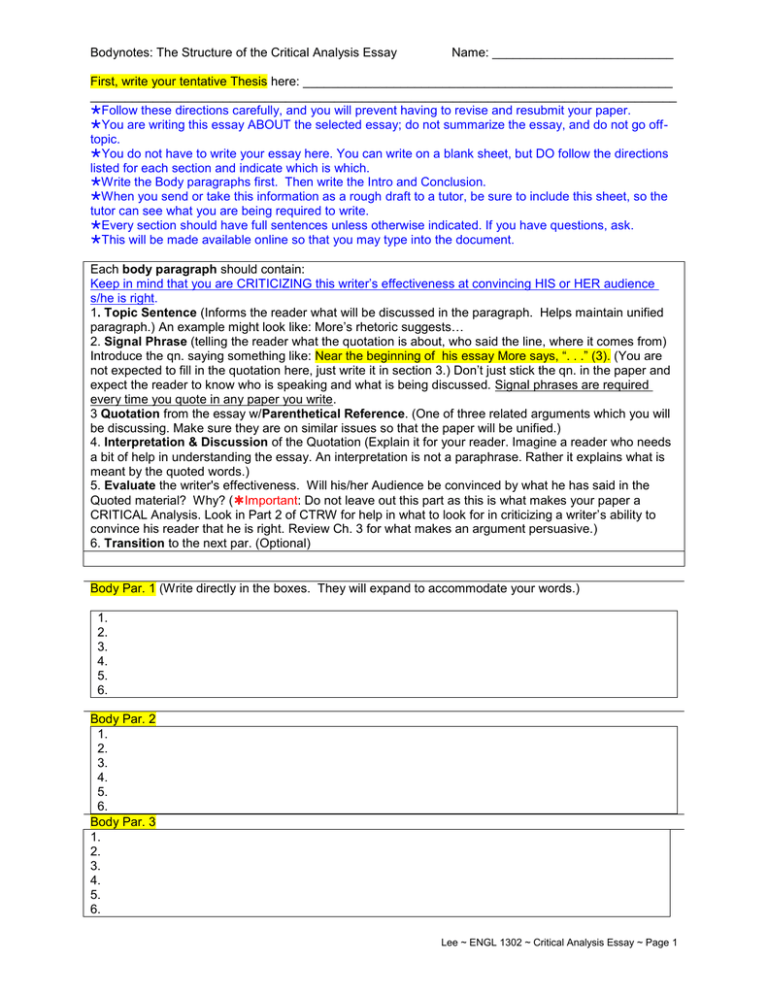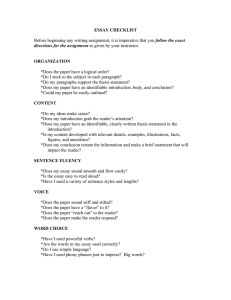Nathanael Lee - Bodynotes 123.doc
advertisement

Bodynotes: The Structure of the Critical Analysis Essay Name: __________________________ First, write your tentative Thesis here: _____________________________________________________ ____________________________________________________________________________________ Follow these directions carefully, and you will prevent having to revise and resubmit your paper. You are writing this essay ABOUT the selected essay; do not summarize the essay, and do not go offtopic. You do not have to write your essay here. You can write on a blank sheet, but DO follow the directions listed for each section and indicate which is which. Write the Body paragraphs first. Then write the Intro and Conclusion. When you send or take this information as a rough draft to a tutor, be sure to include this sheet, so the tutor can see what you are being required to write. Every section should have full sentences unless otherwise indicated. If you have questions, ask. This will be made available online so that you may type into the document. Each body paragraph should contain: Keep in mind that you are CRITICIZING this writer’s effectiveness at convincing HIS or HER audience s/he is right. 1. Topic Sentence (Informs the reader what will be discussed in the paragraph. Helps maintain unified paragraph.) An example might look like: More’s rhetoric suggests… 2. Signal Phrase (telling the reader what the quotation is about, who said the line, where it comes from) Introduce the qn. saying something like: Near the beginning of his essay More says, “. . .” (3). (You are not expected to fill in the quotation here, just write it in section 3.) Don’t just stick the qn. in the paper and expect the reader to know who is speaking and what is being discussed. Signal phrases are required every time you quote in any paper you write. 3 Quotation from the essay w/Parenthetical Reference. (One of three related arguments which you will be discussing. Make sure they are on similar issues so that the paper will be unified.) 4. Interpretation & Discussion of the Quotation (Explain it for your reader. Imagine a reader who needs a bit of help in understanding the essay. An interpretation is not a paraphrase. Rather it explains what is meant by the quoted words.) 5. Evaluate the writer's effectiveness. Will his/her Audience be convinced by what he has said in the Quoted material? Why? (Important: Do not leave out this part as this is what makes your paper a CRITICAL Analysis. Look in Part 2 of CTRW for help in what to look for in criticizing a writer’s ability to convince his reader that he is right. Review Ch. 3 for what makes an argument persuasive.) 6. Transition to the next par. (Optional) Body Par. 1 (Write directly in the boxes. They will expand to accommodate your words.) 1. 2. 3. 4. 5. 6. Body Par. 2 1. 2. 3. 4. 5. 6. Body Par. 3 1. 2. 3. 4. 5. 6. Lee ~ ENGL 1302 ~ Critical Analysis Essay ~ Page 1 Now (AFTER creating the Body) write the Introduction and Conclusion: Introduction Reminders: Use full sentences. 1. Make an interesting opening remark. 2. State the author’s name and the title of the essay you are analyzing 3. Summarize the essay you are analyzing. 4. Who is the author’s audience? Purpose? 5. Tell your reader what your essay will be about. What will you discuss in Body Paragraphs 1, 2, & 3? 6. State your thesis. (What is your paper going to discuss? Thesis should make a statement indicating how you are going to criticize the essay you are analyzing.) Introduction: 1. 2. 3. 4. 5. Conclusion Reminders: Use full sentences. 1. Tie together what you have already said in your paper. 2. Review what was said in Body Paragraphs 1, 2, & 3. 3. Summarize what you have said about whether the author’s audience is convinced by his essay. 4. Restate your thesis. 5. Make an interesting closing remark. Conclusion: 1. 2. 3. 4. 5. Now edit and revise what you have said putting it into a completed Critical Analysis of your selected essay. Mistakes to avoid: 1. Sometimes students wait until the conclusion to indicate whether an author has written persuasively. This is incorrect. EVERY paragraph should indicate whether and why the author has or has not written a persuasive argument. Refer to Ch. 3, CI for help with this. You should be looking for whether an author has used definition or deductive logic. Has the author used an authoritative source? Has she used a logical fallacy (Barnet & Bedau 368-381). Etc. 2. Students often create a parenthetical reference incorrectly. You are expected to study the correct format and use it for every formal paper written in this class including the Midterm and Final. Really look at where the period sits. Notice there is only one period, not two. Notice there is NO COMMA in the parenthetical reference. Example: “xxx” (Smith 455). Example 2: (Barnet & Bedau 333) – Here there are two authors. When you are not sure how to create the parenthetical reference, LOOK IT UP! Don’t guess. You are in school, and a great part of your job is to educate yourself. In reality, the teacher can only lead you to the answers. She cannot put them into your head for you. Think about it. 3. Use PRESENT TENSE when writing about a literary piece whether it is an essay or a poem. 4. Students often fail to interpret quotations. It is important to explain what a quotation means. In doing this you show your reader that you understand what the qn means, and you also guide the reader, so she understands the qn in the same way you do. In other words you are persuading your reader that your interpretation is the right one. 5. Students often use YOU or I in their papers. Never do this in formal writing as it weakens your statements. Why? Who is that “you” you talk about in your paper? Usually it means both Lee ~ ENGL 1302 ~ Critical Analysis Essay ~ Page 2 somebody and nobody. In other words you mean no one specifically. Find a different way to make your “you” statement: Instead of “When you walk down the street,” say “When people walk down the street.” In the same when you say, “In my opinion Mary is tall,” or “I think Mary is tall,” people will be led to question your statement because it is ONLY your opinion. Study how much more power there is to this statement: “Mary is tall.” You are saying the same thing, but you are not quibbling about it; you are simply stating what you perceive to be a fact. This is a much stronger way to make the “same” statement. Lee ~ ENGL 1302 ~ Critical Analysis Essay ~ Page 3


